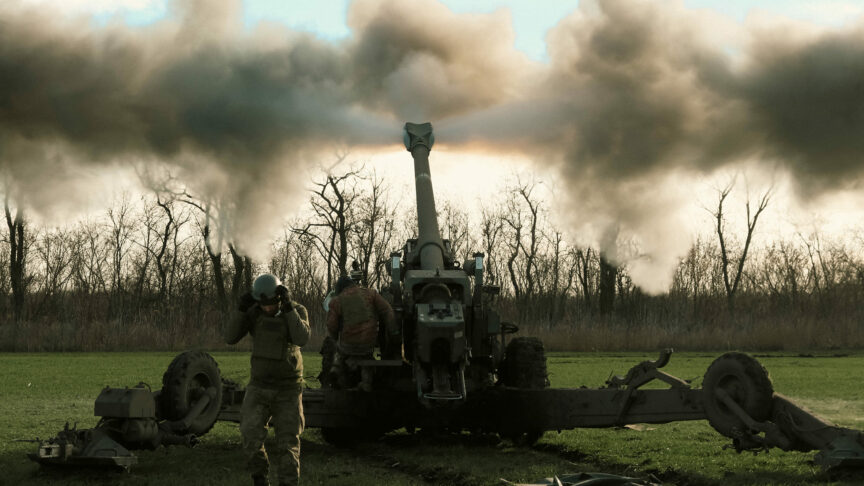Dmytro Kryvosheiev

No one doubts that Ukraine would not have been able to sustain a prolonged full-scale war with Russia without Western arms supplements. In 2022, Western allies expanded the list of equipment they delivered to Ukraine from anti-tank weapons to advanced modern air defence systems and battle tanks. But these arms were always sent to address the critical situations that Ukraine faced.
In the first weeks of the war, Ukraine’s artillery forces caused significant damage to Russia’s heavy armoured vehicles. But they were outnumbered and outgunned, and Russian losses would have been much higher if Western allies had provided artillery and multiple launch rocket systems to Ukraine at this stage. It was not until April 2022 that the United States sent M777 howitzers to Ukraine.
Fast forward a couple of months to when Russia concentrated most of its forces in eastern Ukraine to seize the Luhansk and Donetsk regions: through most of April and May, Russian troops bombed Ukrainian positions with tens of thousands of shells every day. In April, Ukraine’s president Volodymyr Zelensky and his advisers appealed for Western equipment, asking for fighter jets, but also artillery, tanks, and air defence systems. By late May, the situation in eastern Ukraine had become critical for the Ukrainian armed forces. And then, in June, the US and the United Kingdom decided to deliver the multiple launch rocket systems HIMARS and M270 respectively to Ukraine.
HIMARS and its analogue M270 were game-changing weapons for Ukraine, helping the armed forces to undermine Russian tactics and slow down its supply of ammunition. In April 2022, it became clear that Russia could not seize any significant area without total artillery dominance. The HIMARS system significantly weakened the Russian army’s ability to conduct massive artillery attacks – which had been one of its primary tactics. By August 2022, after the HIMARS delivery, Russia’s daily munition expenditure in eastern Ukraine had reduced from nearly 12,000-15,000 rounds to around 5,000-6,000. The Ukrainian armed forces also began to use HIMARS and M270 systems to destroy Russian ammunition depots and command posts, which significantly slowed down the Russian offensive.
Once more, if allies had delivered these a couple of months earlier, the Ukrainian armed forces would have been able to mount a more successful counter-offensive and may not have lost all of the Luhansk region – or, at least, not such important cities as Severodonetsk and Lysychansk. Russian forces captured these cities by breaking the Ukrainian defence line in Popasna with heavy artillery fires.
A few months later, Western allies agreed to supply modern air defence systems: in October 2022 the US delivered the NASAMS system and Germany delivered the IRIS-T, later announcing that it would send its Patriot system as well. In January 2023, Canada said that it would send an additional NASAMS system to Ukraine. This was also in response to Russia ramping up its offensive by launching mass missile attacks against Ukrainian civilians. From October 2022 to January 2023, Russia launched hundreds of ballistic and cruise missiles, as well as suicide drones, which terrorised Ukrainian civilians. These attacks caused electricity blackouts and created panic among civilians. By the time the US and Germany delivered the first modern air defence systems in October 2022, around 30 per cent of energy infrastructure in Ukraine had been hit by Russian missiles.
These examples demonstrate that Western allies have chosen a reactive approach to the military support of Ukraine, rather than a proactive one, with severe consequences. Western allies are slowly expanding the range of military assistance for Ukraine in an attempt to avoid escalation with the Kremlin, which regards any additional arms support for Ukraine as a deepening of NATO’s involvement in the conflict.
But if the West wants Ukraine to win the war with Russia – or at least push Russian forces back to the 24 February frontline – it needs to reconsider its approach to military support.
The Kremlin has repeatedly blackmailed the US and the EU, saying that it will escalate the war if they provide more weapons to Ukraine, but nothing has come of these threats
Firstly, Western allies should provide Ukraine with more game-changing military equipment before the situation becomes critical again for the Ukrainian armed forces. The recent announcement of the delivery of hundreds of modern tanks to Ukraine in order to prepare it for a counter-offensive is a step in the right direction. Now that Russia has moved its ammunition depots and command points back to up to 100-120km from the frontline, Ukraine needs equipment to reach this distance. A clear next step for Western allies would be providing Western fighter jets and missiles that can reach 150km and further, such as the ATACMS – which the US, Poland, and Romania could send – and the GLSDB, which the US plans to supply.
Secondly, Western allies should shift their arms supply policy to focus on what Ukraine needs, rather than how Russia may react. The Kremlin has repeatedly blackmailed the US and the European Union, saying that it will escalate the war if they provide more weapons to Ukraine, but nothing has come of these threats. The US and European countries should learn from this experience and assume that nothing will change for the West if they provide Ukraine with new critical weapons.
Finally, Western allies should adjust their expectations of Ukraine’s campaign for 2023. It is highly unlikely that the war will end this year. The US and European governments should therefore focus on helping Ukraine to conduct at least one significant and successful offensive this year, for instance in the southern direction aiming to cut off occupied Donbas from Crimea via the Russian land bridge. And it should arm Ukraine in advance of – not in response to – this next stage of the war.
No comments:
Post a Comment